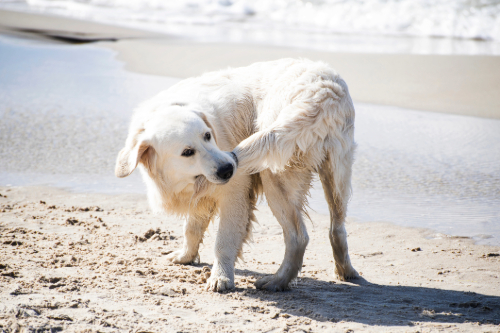Have you ever noticed your dog walking in circles and wondered what’s going on? It’s a behavior that can be both puzzling and concerning for pet owners. In this blog, we’ll explore the various reasons why dogs might exhibit this behavior and offer guidance on how to respond effectively. If you have concerns or need professional advice, don’t hesitate to call McGehee Clinic for Animals in Memphis, TN, at (262) 658-3533.
Common Causes for Circular Walking in Dogs
- Playfulness and Excitement: Often, dogs will walk or run in circles when they’re excited or eager about something, like mealtime or playtime. This is typically a harmless behavior reflecting their enthusiasm.
- Chasing Their Tail: Some dogs engage in tail chasing as a form of play or due to a flea or skin irritation. While it can be amusing, excessive tail chasing should be monitored.
- Ear Infections: Dogs with ear infections may walk in circles due to the discomfort or disorientation caused by the infection. Other symptoms might include head shaking and scratching at the affected ear.
- Canine Vestibular Disease: This condition affects a dog’s balance system, often leading to circling, dizziness, and potential nausea. It’s more common in older dogs but can occur at any age.
- Neurological Issues: More serious causes of circular walking can be neurological problems, like seizures, brain tumors, or stroke. These conditions may require immediate veterinary attention.
A Closer Look at Canine Vestibular Disease
Canine vestibular disease is an important condition to understand, especially since it’s a common cause of circular walking and head tilts in dogs. This condition involves the vestibular apparatus located in the inner ear and brain, responsible for maintaining a sense of balance.
- Symptoms: The most common signs include a noticeable head tilt, unsteady gait, circling, nystagmus (rapid eye movement), vomiting, and difficulty standing.
- Causes: It can stem from various causes, including ear infections, head trauma, tumors, or it may be idiopathic (having no identifiable cause). The idiopathic form is especially common in older dogs.
- Diagnosis: Diagnosing this condition involves a thorough physical and neurological examination. Your vet may also recommend blood tests, MRI, or CT scans to rule out other causes.
- Treatment: Treatment focuses on managing symptoms and addressing the underlying cause if known. In cases of idiopathic vestibular disease, symptoms often improve within a few days, though the head tilt may persist.
- Prognosis: The prognosis is generally good, especially for dogs with the idiopathic form. Most dogs recover well with supportive care, although some may have residual symptoms like a head tilt.
When Circular Walking Signals a Serious Condition
- Persistent or Compulsive Circling: If your dog is constantly walking in circles, it could indicate a serious health issue needing immediate veterinary care.
- Accompanied by Other Symptoms: Be alert to other symptoms like loss of balance, changes in eyesight, lethargy, or behavioral changes, which could point to more significant health concerns.
- Sudden Onset: A sudden start of this behavior, especially in older dogs, warrants a vet check-up to rule out serious conditions like stroke or brain tumors.
Step-by-Step Guide for Responding to Circular Walking
- Observe: First, watch your dog’s behavior. Note if the circling is occasional or persistent, and whether other symptoms are present.
- Check for Obvious Causes: Look for fleas, ticks, or skin irritations, and ensure their environment is safe and free from stressors.
- Minimize Disorientation: If your dog seems dizzy or unsteady, minimize their movement to prevent injury. Create a calm, comfortable space for them.
- Consult a Vet: If you’re unsure about the cause or if other symptoms are present, it’s best to seek professional advice. Early intervention can be crucial for some conditions.
- Follow Veterinary Advice: Your vet might recommend treatments or diagnostics like blood tests or imaging. It’s important to follow their guidance closely.
When to Seek Veterinary Care
If the behavior continues for more than a day or seems to be worsening, contact your vet. Signs of distress, pain, balance issues, or changes in consciousness, or behavior may indicate a more serious issue. Even if you can’t identify a clear reason for the behavior, it’s always best to err on the side of caution and get a professional opinion. Our team at McGehee Clinic for Animals is here to provide the very best care for your pet and provide you with peace of mind.
Diagnostic Process
Understanding why a dog is walking in circles often requires a thorough diagnostic process. At McGehee Clinic for Animals, we approach this concern with a comprehensive evaluation to determine the underlying cause. If your dog exhibits this behavior, here’s what you can expect during the diagnosis process:
- Initial Consultation and History: Our first step is gathering a detailed history of your dog’s health and behavior. This includes understanding when the circling behavior began, its frequency, and any other noticeable changes in your dog’s health or demeanor.
- Physical Examination: A thorough physical exam is conducted to check for any external signs that could explain the behavior, such as ear infections, skin irritations, or injuries.
- Neurological Evaluation: Since circling can be associated with neurological issues, a neurological exam is essential. This assessment helps identify any abnormalities in your dog’s nervous system that could be contributing to the behavior.
- Diagnostic Testing: Depending on the initial findings, we may recommend diagnostic tests. These can include blood tests, urinalysis, and fecal exams to rule out infections or systemic diseases. Imaging tests might also be necessary to evaluate the brain and inner ear structures.
- Observational Analysis: Sometimes, observing the dog’s behavior in different environments or situations provides valuable clues. This can help differentiate between behavioral causes and medical issues.
- Referral to Specialists: In some cases, we might refer your dog to a veterinary specialist, such as a neurologist or behaviorist, for further evaluation.
- Treatment Plan Development: Once we have a diagnosis, we’ll develop a tailored treatment plan. This plan might include medication, therapy, dietary changes, or behavior modification techniques, depending on the underlying cause.
- Follow-Up Care: Ongoing follow-up is important to monitor your dog’s response to treatment and make any necessary adjustments.
Contact McGehee Clinic for Animals
While a dog walking in circles might be nothing to worry about, it’s important to be aware of when this behavior could signal a deeper health issue. Always observe your dog closely and don’t hesitate to reach out for professional help if needed. Remember, at McGehee Clinic for Animals, we’re here to assist with all your pet health concerns. If you have any questions or need to schedule an appointment for your dog, please call us at (262) 658-3533. Your dog’s health and well-being are our top priority, and we’re committed to providing the best care possible.





